
The Dominican economy created 173 thousand jobs in the last 12 months and employment reached its highest historical level of 5,029,347 workers in the third quarter of 2024, for a growth of 3.6%.
Meanwhile, the open unemployment rate stood at 5.3% in that period, as revealed by the governor of the Dominican Central Bank (BCRD), Héctor Valdez Albizu, during the celebration of the 77th anniversary of the BCRD.
The percentage of informal employment fell from 56.7% in July-September 2023 to 55.3% in the same period of 2024, according to preliminary data from the National Labor Force Ongoing Survey (ENCFT).
This is because the creation of new jobs over the last twelve months was focused on formal employment, that is, those who have access to social security benefits through their occupation, specifically, of the 173 thousand jobs created, 144 thousand were formal jobs, for a year-on-year growth of 6.9%.
On the other hand, Valdez Albizu explained that monetary poverty stood at 19.0% in the second quarter of 2024, a reduction of 4.5 percentage points compared to the same period in 2023, according to data estimated by the Inter-Institutional Technical Committee for measuring monetary poverty. This advance is mainly attributed to the increase in the nominal per capita income of Dominican households.
Regarding the consumer index (CPI), year-on-year inflation stood at 3.29% in September 2024 and core inflation, which reflects the monetary conditions of the economy, reached 4.01% in that month.
The governor explained that in the current context of lower inflation and more favorable monetary conditions, private loans in national currency grew by 14% year-on-year in September, highlighting the channeling of resources to trade, construction, housing acquisition and household consumption. Likewise, the pace of expansion of the broader monetary aggregates was around the growth of nominal gross domestic product (GDP).
As for the external sector, total exports stood at US$10,452.4 million in January-September 2024, for a year-on-year variation of 6.1%, driven by foreign sales from free zones, which grew 7.5%, reaching an all-time high of US$6,404.1 million. Similarly, national exports reached US$4,048.3 million, an increase of 4.1% compared to the same period of the previous year.
On the other hand, in January-September 2024, about US$8,000 million were received in remittances, an increase of 5.3% compared to the same period last year. Remittances, together with income from foreign direct investment, exports and tourism, contributed to the relative stability of the exchange rate with a cumulative depreciation of the peso of just 3.3%.
Likewise, at the end of September, international reserves were US$14,474.8 million, equivalent to 5.5 months of imports and 11.6% of GDP, above the metrics recommended by the International Monetary Fund (IMF).
In his speech, Valdez Albizu recalled that the monthly indicator of economic activity (IMAE) registered a year-on-year growth of 5.6% in August of this year, accumulating an expansion of 5.1% in January-August 2024. This result places the country as the fastest growing economy in Latin America to date.
The sectors that drove growth in the January-August period were free zones (6.6%) and construction (4.9%), the latter activity with a large multiplier effect on other economic sectors. Likewise, the services sector expanded 5.4% year-on-year, mainly supported by financial services (8.1%), hotels, bars and restaurants (7.1%), transportation and storage (5.9%), real estate and rental activities (5.8%) and communications (5.3%).
The governor emphasized that, as the institutional manager of the payment interconnection system of the countries that make up the Central American Monetary Council, the Central Bank has played a key role in facilitating our payment platform to make transfers of funds between these nations, which increased by 368% at the end of September of this year compared to 2023.
Another relevant fact expressed by Valdez Albizu is that there are currently 5,620 banking subagents operating throughout the country, mobilizing over RD$ 33 billion.
Growth, tourism and banking
Valdez Albizu said that tourism has become the backbone of economic growth, and its dynamism is reflected in a diversified supply of services and in the growing external demand for the country’s tourist attractions.
He said that during the first eight months of the year 6.0 million tourists arrived by air, added to 1.8 million cruise passengers, yielding a grand total of 7.8 million visitors. During this period, the hotels, bars and restaurants activities grew 7.1%, becoming the second segment of the services sector that generated the highest added value, after financial services, which grew 8.1%.
Financial intermediary sector assets
The governor of the BCRD revealed that, as of September 2024, these assets grew 10.6%, driven by the increase in private credit in national currency. The governor acknowledged the role of the financial sector as a support for private productive activity and said that it continues to perform well according to its levels of liquidity, profitability and solvency.
He indicated that the loan portfolio delinquency reached 1.4%, while the coverage of provisions for the non-performing loan portfolio was greater than 100%, which shows a low risk level. He also said that the system’s solvency stood at 17.7% in July 2024, well above the 10% required by the regulations, while, as of September, the return on equity (ROE) was 24.2% and the return on assets (ROA) was 2.9%.
Valdéz Albizu explained that between January-September 2024 alone, a daily average of 2.6 million electronic payment transactions are registered, which represents a growth of 20% compared to the same period in 2023.
Source:



